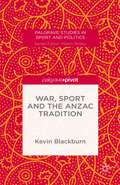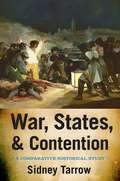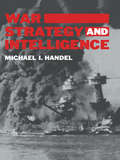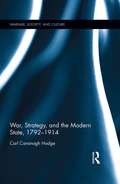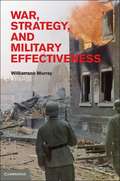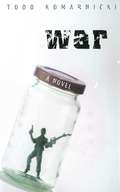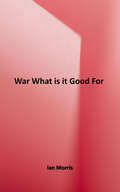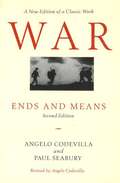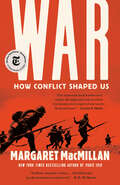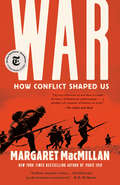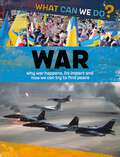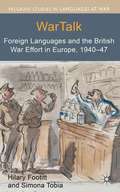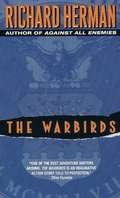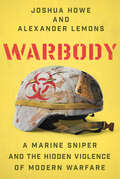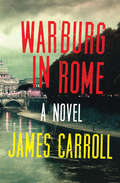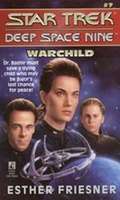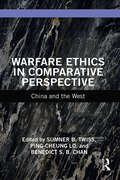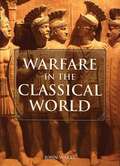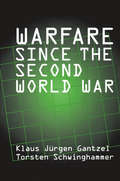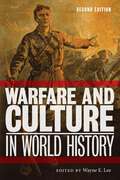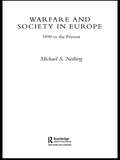- Table View
- List View
War, Sport and the Anzac Tradition (Palgrave Studies in Sport and Politics)
by Kevin BlackburnCommemoration of war is done through sport on Anzac Day to remember Australia's war dead. War, Sport and the Anzac Tradition traces the creation of this sporting tradition at Gallipoli in 1915, and how it has evolved from late Victorian and Edwardian ideas of masculinity extolling prowess on the sports field as fostering prowess on the battlefield.
War, States, and Contention: A Comparative Historical Study
by Sidney TarrowFor the last two decades, Sidney Tarrow has explored "contentious politics"--disruptions of the settled political order caused by social movements. These disruptions range from strikes and street protests to riots and civil disobedience to revolution. In War, States, and Contention, Tarrow shows how such movements sometimes trigger, animate, and guide the course of war and how they sometimes rise during war and in war's wake to change regimes or even overthrow states. Tarrow draws on evidence from historical and contemporary cases, including revolutionary France, the United States from the Civil War to the anti-Vietnam War movement, Italy after World War I, and the United States during the decade following 9/11. In the twenty-first century, movements are becoming transnational, and globalization and internationalization are moving war beyond conflict between states. The radically new phenomenon is not that movements make war against states but that states make war against movements. Tarrow finds this an especially troublesome development in recent U.S. history. He argues that that the United States is in danger of abandoning the devotion to rights it had expanded through two centuries of struggle and that Americans are now institutionalizing as a "new normal" the abuse of rights in the name of national security. He expands this hypothesis to the global level through what he calls "the international state of emergency."
War, Strategy and Intelligence (Studies in Intelligence)
by Michael I. HandelInvestigating the logic, conduct and nature of war on the highest political and strategic levels, these essays put less emphasis on operational and tactical aspects. They look at the impact of technology on warfare, the political nature of war and the limits of rational analysis in studying war.
War, Strategy and the Modern State, 1792–1914 (Warfare, Society and Culture)
by Carl Cavanagh HodgeThis book is a comparative study of military operations conducted my modern states between the French Revolution and World War I. It examines the complex relationship between political purpose and strategy on the one hand, and the challenge of realizing strategic goals through military operations on the other. It argues further that following the experience of the Napoleonic Wars military strength was awarded a primary status in determining the comparative modernity of all the Great Powers; that military goals came progressively to distort a sober understanding of the national interest; that a genuinely political and diplomatic understanding of national strategy was lost; and that these developments collectively rendered the military and political catastrophe of 1914 not inevitable yet probable.
War, Strategy, and Military Effectiveness
by Williamson MurrayThis collection of articles represents Professor Williamson Murray's efforts to elucidate the role that history should play in thinking about both the present and the future. They reflect three disparate themes in Professor Murray's work: his deep fascination with history and those who have acted in the past; his fascination with the similarities in human behavior between the past and the present; and his belief that the study of military and strategic history can be of real use to those who will confront the daunting problems of war and peace in the twenty-first century. The first group of essays addresses the relevance of history to an understanding of the present and to an understanding of the possibilities of the future. The second addresses the possible direct uses of history to think through the problems involved in the creation of effective military institutions. The final group represents historical case studies that serve to illuminate the present.
War, Torture and Terrorism: Rethinking the Rules of International Security (Contemporary Security Studies)
by Jr. Amanda Russell Beattie Anthony F. LangThis book seeks to demonstrate how rules not only guide a variety of practices within international politics but also contribute to the chaos and tension on the part of agents in light of the structures they sustain. Four central themes- practice, legitimacy, regulation, and responsibility- reflect different dimensions of a rule governed political order. The volume does not provide a single new set of rules for governing an increasingly chaotic international system. Instead, it provides reflections upon the way in which rules can and cannot deal with practices of violence. While many assume that "obeying the rules" will bring more peaceful outcomes, the chapters in this volume demonstrate that this may occur in some cases, but more often than not the very nature of a rule governed order will create tensions and stresses that require a constant attention to underlying political dynamics. This wide-ranging volume will be of great interest to students of International Law, International Security and IR theory.
War, the American State, and Politics since 1898
by Robert P. Saldin"This book examines major foreign conflicts from the Spanish-American War through Vietnam, arguing that international conflicts have strong effects on American political parties, elections, state development, and policymaking. First, major wars expose and highlight problems requiring governmental solutions or necessitating emergency action. Second, despite well-known curtailments of civil liberties, wars often enhance democracy by drawing attention to the contributions of previously marginalized groups and facilitating the extension of fuller citizenship rights to them. Finally, wars affect the party system. Foreign conflicts create crises - many of which are unanticipated - that require immediate attention, supplant prior issues on the policy agenda, and engender shifts in party ideology. These new issues and redefinitions of party ideology frequently influence elections by shaping both elite and mass behavior"--
War: A Beginner's Guide (Beginner's Guides)
by Aaron EdwardsWar has been a perennial feature of human history since ancient times, yet it remains a poorly understood phenomenon. It has done much to shape our world, from overthrowing leaders, establishing international governance, and inspiring social change, to destroying cities, dividing nations and breeding animosity.In this book, Dr Aaron Edwards succinctly combines political theories with historical realities. Using eyewitness accounts, war poetry and insightful analysis of a wide range of conflicts, War: A Beginner's Guide introduces the reader to the complexity and human face of war and invites readers to question whether violence is the most effective way to resolve disputes.
War: A Novel
by Todd KomarnickiThe soldier is alone. He doesnÕt know where he is or how he got here. All he does know is that he is at war. But who is the enemy? Who is this army of strangers? Surrounded by a ruined city, without a compass to guide him or a clear mission to fulfill, the soldier must rely on what he has left to survive. Using only memory, his warriorÕs skills, and his own, suddenly fierce humanity, he will construct a map to lead him toward what he desperately hopes will be his escape . . . but could just as easily mean his end. WAR is the story of one manÕs journey deep into the heart of violence, and even deeper into his own soul. It is an indelible story for our time.
War: Conflict and the Progress of Civilization From Primates to Robots
by Ian MorrisWar is one of the greatest human evils. It has ruined livelihoods, provoked unspeakable atrocities and left countless millions dead. It has caused economic chaos and widespread deprivation. And the misery it causes poisons foreign policy for future generations. <p><p> But, argues bestselling historian Ian Morris, in the very long term, war has in fact been a good thing. In his trademark style combining inter-disciplinary insights, scientific methods and fascinating stories, Morris shows that, paradoxically, war is the only human invention that has allowed us to construct peaceful societies. Without war, we would never have built the huge nation-states which now keep us relatively safe from random acts of violence, and which have given us previously unimaginable wealth. It is thanks to war that we live longer and more comfortable lives than ever before. <p><p> And yet, if we continue waging war with ever-more deadly weaponry, we will destroy everything we have achieved; so our struggles to manage warfare make the coming decades the most decisive in the history of our civilization. In War: What Is It Good For? Morris brilliantly dissects humanity's history of warfare to draw startling conclusions about our future.
War: Ends and Means (2nd edition)
by Angelo Codevilla Paul SeaburyThis book explores the causes, operations, endings, and justifications of war. In the process, it demolishes many currently fashionable illusions, such as that peace is always preferable to war, that wars occur because of accidents or misunderstandings, and that technology changes the nature of war. Abundant historical and contemporary examples show, the authors contend, that all wars are deliberate political choices, that military operations follow timeless principles, and that, as Aristotle taught, the natural aim of war is victory. This new edition of the book that Eugene Rostow called “a gem,” Michael Howard called “shrewd and trenchant,” and Library Journal called “persuasive” devotes substantial attention to the wars of the post–Cold War period, including “the war on terrorism.”
War: How Conflict Shaped Us
by Margaret MacMillanIs peace an aberration? <P><P>The bestselling author of Paris 1919 offers a provocative view of war as an essential component of humanity. <P><P> The instinct to fight may be innate in human nature, but war—organized violence—comes with organized society. War has shaped humanity’s history, its social and political institutions, its values and ideas. Our very language, our public spaces, our private memories, and some of our greatest cultural treasures reflect the glory and the misery of war. War is an uncomfortable and challenging subject not least because it brings out both the vilest and the noblest aspects of humanity. <P><P>Margaret MacMillan looks at the ways in which war has influenced human society and how, in turn, changes in political organization, technology, or ideologies have affected how and why we fight. War: How Conflict Shaped Us explores such much-debated and controversial questions as: When did war first start? Does human nature doom us to fight one another? Why has war been described as the most organized of all human activities? Why are warriors almost always men? Is war ever within our control? <P><P>Drawing on lessons from wars throughout the past, from classical history to the present day, MacMillan reveals the many faces of war—the way it has determined our past, our future, our views of the world, and our very conception of ourselves.
War: How Conflict Shaped Us
by Margaret MacMillanThoughtful and brilliant insights into the very nature of war--from the ancient Greeks to modern times--from world-renowned historian Margaret MacMillan. War--its imprint in our lives and our memories--is all around us, from the metaphors we use to the names on our maps. As books, movies, and television series show, we are drawn to the history and depiction of war. Yet we nevertheless like to think of war as an aberration, as the breakdown of the normal state of peace. This is comforting but wrong. War is woven into the fabric of human civilization. In this sweeping new book, international bestselling author and historian Margaret MacMillan analyzes the tangled history of war and society and our complicated feelings towards it and towards those who fight. It explores the ways in which changes in society have affected the nature of war and how in turn wars have changed the societies that fight them, including the ways in which women have been both participants in and the objects of war.MacMillan's new book contains many revelations, such as war has often been good for science and innovation and in the 20th century it did much for the position of women in many societies. But throughout, it forces the reader to reflect on the ways in which war is so intertwined with society, and the myriad reasons we fight.
War: What Can We Do? (What Can We Do? #1)
by Alex WoolfA look at two of the biggest challenges facing our world today - war and conflict - and how we are tackling themWar and conflict have been part of the human experience for thousands of years, and take many different forms - from diplomatic cold wars to full-blown conflicts lasting many years. All wars are damaging and harmful, not only for those on the frontline, but for innocent people and children everywhere. So what can we do to make our world more peaceful?How can we build a better, fairer, more equal, cleaner world? This series seeks to answer this by exploring some of the greatest challenges facing our planet today - from disease to conflict, and from the energy crisis to the plight of refugees. It explains what is already being done to meet and tackle these challenges, and explores what more could and should be done, both individually and collectively, to ensure a better future for our planet, its people and its wildlife.Taking a positive, but realistic perspective, this series aims to empower young readers by helping them understand these complex and troubling issues, calm their anxieties, and promote empathy and understanding for the many millions of people suffering from for example, poverty or inequality.Perfect for readers aged 9 and upTitles in the series:Climate ChangeDiseaseInequalityMigrationPoverty & Food InsecurityWar & Conflict
WarTalk
by Hilary Footitt Simona TobiaOffering a new perspective on the British experience of the Second World War in Europe, this book provides a series of snapshots of the role which languages played in the key processes of British war-making, moving from frameworks of perception and intelligence gathering, through to liberation/occupation, and on to the aftermath of conflict.
Warbirds
by Richard HermanColonel Anthony "Muddy" Waters has a mission: to mold a company of poorly trained rogues and misfits into heroes. His assignment is one that no other officer in the United States Air Force would touch. But Waters has a fabled stubbornness and dedication unparalleled in the armed services ... and the will to make the impossible possible. The Warbirds is the breakthrough novel that captures the saga of the F-4 Phantom and the men who made it a legend: like "Muddy" Waters, who must transform the men and women under his command -- Including a superbly talented pilot but loose cannon named Jack Locke-into a fighting force to be reckoned with. Because their country could ask them at any time to fly their F-4s into the eye of the firestorm, to face an overwhelming enemy and brave the flames of hell itself without question and with no support. Tomorrow that call will come. And there will be no turning backwhen the heavens explode.
Warbody: A Marine Sniper and the Hidden Violence of Modern Warfare
by Joshua Howe Alexander LemonsA friendship between an environmental historian and a chronically ill US Marine yields a powerful exploration into the toxic effects of war on the human body. Alexander Lemons is a Marine Corps scout sniper who, after serving multiple tours during the Iraq War, returned home seriously and mysteriously ill. Joshua Howe is an environmental historian who met Lemons as a student in one of his classes. Together they have crafted a vital book that challenges us to think beyond warfare’s acute violence of bullets and bombs to the “slow violence” of toxic exposure and lasting trauma. In alternating chapters, Lemons vividly describes his time in Fallujah and elsewhere during the worst of the Iraq War, his descent into a decade-long battle with mysterious and severe sickness, and his return to health; Howe explains, with clarity and scientific insight, the many toxicities to which Lemons was exposed and their potential consequences. Together they cover the whirlwind of toxic exposures military personnel face from the things they touch and breathe in all the time, including lead from bullets, jet fuel, fire retardants, pesticides, mercury, dust, and the cocktail of toxicants emitted by the open-air “burn pits” used in military settings to burn waste products like paint, human waste, metal cans, oil, and plastics. They also consider PTSD and traumatic brain injury, which are endemic among the military and cause and exacerbate all kinds of physical and mental health problems. Finally, they explore how both mainstream and alternative medicine struggle to understand, accommodate, and address the vast array of health problems among military veterans. Warbody challenges us to rethink the violence we associate with war and the way we help veterans recover. It is a powerful book with an urgent message for the nearly twenty million Americans who are active military or veterans, as well as for their families, their loved ones, and all of us who depend on their service.
Warburg in Rome: A Novel
by James CarrollIn post-WWII Italy, an American uncovers a Vatican scandal in a &“thriller with deeply serious historical undertones&” by a National Book Award winner (Alan Cheuse, NPR, All Things Considered). David Warburg, newly minted director of the US War Refugee Board, arrives in Rome at war&’s end, determined to bring aid to the destitute European Jews streaming into the city. Marguerite d&’Erasmo, a French-Italian Red Cross worker with a shadowed past, is initially Warburg&’s guide—while a charismatic young American Catholic priest, Monsignor Kevin Deane, seems equally committed to aiding Italian Jews. But the city is a labyrinth of desperate fugitives: runaway Nazis, Jewish resisters, and criminal Church figures. Marguerite, caught between justice and revenge, is forced to play a double game. At the center of the maze, Warburg discovers one of history&’s great scandals: the Vatican ratline, a clandestine escape route maintained by Church officials and providing scores of Nazi war criminals with secret passage to South America. Turning to American intelligence officials, he learns that the dark secret is not as secret as he thought—and that even those he trusts may betray him—in this &“complex and compelling novel of the Vatican and morality during World War II&” (Library Journal). Warburg in Rome has &“the breathtaking pace of a thriller and the gravitas of a genuine moral center—as if John LeCarré and Graham Greene collaborated&” (Mary Gordon). &“A high-stakes battle between good and evil [and] a plot full of twists and turns.&” —The Boston Globe &“A suspenseful historical drama set in Rome at the end of WWII and centering on Vatican complicity in the flight of Nazi fugitives to Argentina.&” —Publishers Weekly &“Recommend this utterly engaging thriller to fans of Joseph Kanon&’s The Good German and James R. Benn&’s Death&’s Door.&” —Booklist, starred review
Warchild (Star Trek #7)
by Esther FriesnerA message left behind by the Kai Opaka gives Commander Benjamin Sisko a fateful mission: find a young Bajoran girl destined to be a great healer who could bring together the warring factions of Bajor. While Lt. Dax tries to find the healer, Dr. Bashir goes planetside to treat a rare disease that is killing the children in Bajor's resettlement camps. Surrounded by thousands of dying children, Bashir goes A.W.O.L. from Deep Space Nine TM, vowing not to return until the plague has been stopped. But by the time Dax finds the girl from the Kai's prophecy the child has fallen victim to the plague. Now, with the fate of the entire planet at stake, Commander Sisko must find Dr. Bashir in time to save the child who may be Bajor's last chance for peace.
Warfare Ethics in Comparative Perspective: China and the West (War, Conflict and Ethics)
by Sumner B. Twiss Benedict S. B. Chan Ping-CheungThis volume explores East Asian intellectual traditions and their influence on contemporary discussions of the ethics of war and peace.Through cross-cultural comparison and dialogue between East and West, this work charts a new trajectory in the development of applied ethics. A sequel to the volume Chinese Just War Ethics, it expands the range of the earlier work and includes attention to Japan and other Eastern and Western traditions for contrastive reflection and engages with the full range of Chinese intellectual traditions for comparative analysis. The book scrutinizes pioneering works such as the Mengzi, the Han Feizi, and the Seven Military Classics, investigating their influence in subsequent times. It also engages with new texts and thinkers such as the Four Books of the Yellow Emperor, Zeng Guofan, Chiang Kai-shek, and Mao Zedong, along with examining recent writings of the scholars of the People’s Liberation Army. The final section of the book identifies and discusses some emerging issues in the comparative study of military ethics, just war and peace that derive from the preceding sections. The volume editors then offer some concluding remarks at the end of the book.This book will be of much interest to students of the ethics of war and peace, just war theory, military ethics, Asian studies and International Relations in general.
Warfare In The Classical World: An Illustrated Encyclopedia Of Weapons, Warriors, And Warfare In The Ancient Civilizations Of Greece And Rome
by John WarryThis superbly illustrated volume traces the evolution of the art of warfare in the Greek and Roman worlds between 1600 B.C. and A.D. 800, from the rise of Mycenaean civilization to the fall of Ravenna and the collapse of the Western Roman Empire. John Warry tells of an age of great military commanders such as Alexander the Great, Hannibal, and Julius Caesar - men whose feats of generalship still provide material for discussion and admiration in the military academies of the world. The text is complemented by a running chronology, 16 maps, 50 newly researched battle plans and tactical diagrams, and 125 photographs, 65 of them in color.
Warfare Since the Second World War
by Torsten SchwinghammerWarfare Since the Second World War presents a wealth of analysis and data about one of the most pressing questions of our time: why does war continue to plague us fifty years after World War II? This book argues that the nature of war has shifted from inter-state conflicts toward internal conflicts, above all civil war. Low-intensity conflict helps explain the constant increase in wars over the last fifty years and makes it probable this trend will continue. Gantzel and Schwinghammer argue that modern warfare reflects a continuation of the nation-state-building process begun in nineteenth-century Europe.In their analysis, economic modernization and social integration destroy traditional relations and create instability in the developing world. While these forces were successfully harnessed by the modern state in Europe and North America, economic and political globalization make a similar resolution considerably more complex. In addition to their insightful analysis, the authors provide a detailed list of all wars fought from 1945 to 1995. The authors' lucid explanatory commentaries are accompanied by lists, tables, and charts. In addition to a detailed war register, upon which all statistical data and analyses for the volume are based, there are appendices with directories useful for locating specific wars, as well as several supplementary lists. An afterword brings the reader closer to the world situation as we conclude the twentieth century; including the impact of political developments in Eastern Europe.Beyond its historical dimension, this book offers a policy-relevant empirical demonstration of the ongoing increase in internal (civil) wars and addresses the inability of modern society to prevent this scourge. Warfare Since the Second World War is an indispensable resource for anyone concerned with issues of war and peace, development, and the future of international relations.
Warfare and Culture in World History, Second Edition (Warfare And Culture Ser. #9)
by Wayne E. LeeAn expanded edition of the leading text on military history and the role of culture on the battlefieldIdeas matter in warfare. Guns may kill, but ideas determine when, where, and how they are used. Traditionally, military historians attempted to explain the ideas behind warfare in strictly rational terms, but over the past few decades, a stronger focus has been placed on how societies conceptualize war, weapons, violence, and military service, to determine how culture informs the battlefield. Warfare and Culture in World History, Second Edition, is a collection of some of the most compelling recent efforts to analyze warfare through a cultural lens. These curated essays draw on, and aggressively expand, traditional scholarship on war and society through sophisticated cultural analysis. Chapters range from an organizational analysis of American Civil War field armies, to an exploration of military culture in late Republican Rome, to debates within Ming Chinese officialdom over extermination versus pacification.In addition to a revised and expanded introduction, the second edition of Warfare and Culture in World History now adds new chapters on the role of herding in shaping Mongol strategies, Spanish military culture and its effects on the conquest of the New World, and the blending of German and East African military cultures among the Africans who served in the German colonial army. This volume provides a full range of case studies of how culture, whether societal, strategic, organizational, or military, could shape not only military institutions but also actual battlefield choices.
Warfare and Society in British India, 1757–1947 (War and Society in South Asia)
by Kaushik Roy Ashutosh KumarThis book explores the intricate and intimate relationship between military organization, imperial policy, and society in colonial South Asia. The chapters in the volume focus on technology, logistics, and state building. The present volume highlights the salient features of expansion and consolidation of imperial control over the subcontinent, and ultimate demise of the Raj. Further, it turns the spotlight on to subaltern challenges to imperialism as well as the role of non-combatants in warfare. The volume: • Deals with both conventional and guerrilla conflicts and focuses on the frontiers (both North-West and North-East, including Burma); • Looks at the army as an institution rather than present a chronological account of military operations, which highlights the complex and tortuous relationship between combat institution, colonial state, and Indian society; • Integrates top-down approaches in military and strategic studies with the bottom-up perspectives and discusses on how the conduct of war (organisation and technology) is related to the economic, societal, and cultural impact of war. A rich account of the British ‘Army in India’, this book will be essential reading for scholars and researchers of South Asian history, military history, political history, colonialism, and the British Empire.
Warfare and Society in Europe: 1898 to the Present (Warfare And History Ser.)
by Michael S. NeibergWarfare and Society in Europe, 1898 to the Present examines warfare in Europe from the Fashoda conflict in modern-day Sudan to the recent war in Iraq. The twentieth century was by far the world's most destructive century with two global wars marking the first half of the century and the constant fear of nuclear annihilation haunting the second half
